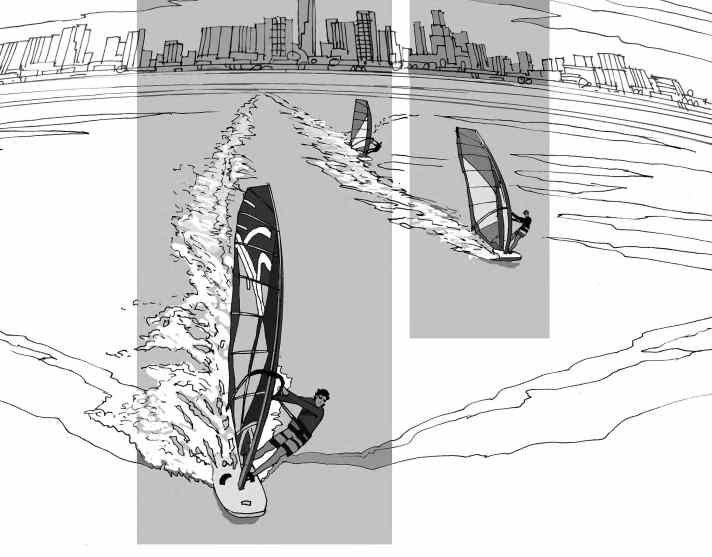Freedom instead of the Olympics: Alex Morales on his escape from Cuba on a windsurfer
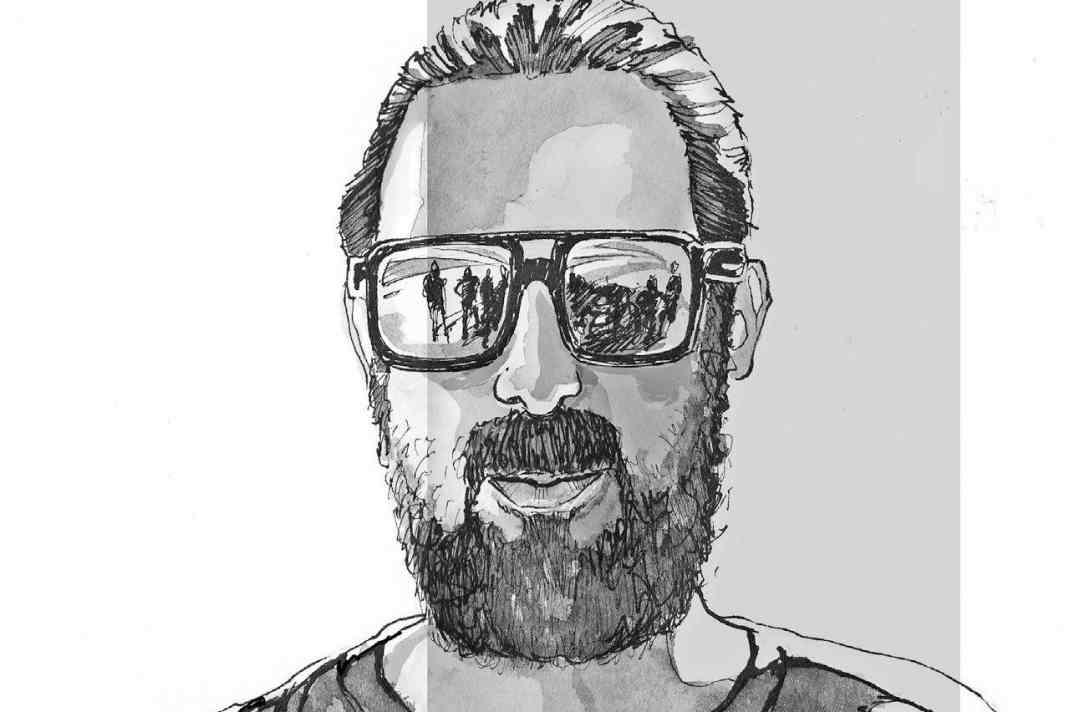





With a windsurfing board to freedom - that certainly sounds familiar to loyal surf readers. In 1986, the two friends Karsten Klünder and Dirk Deckert fled from the GDR to the West. With their self-built boards and rigs, they surfed from Hiddensee on the island of Rügen to the island of Møn in Denmark. They told surf magazine exclusively about their perilous escape through the Iron Curtain.
While the curtain between the GDR and what was then West Germany was slowly being lifted at the end of the 1980s, it was kept tightly closed many thousands of kilometres to the west, in Cuba. Young Alex Morales, who was well on his way to representing his homeland Cuba in the windsurfing discipline at the Olympic Games, found this unbearable. But he decided otherwise, swapping his secure Olympic ticket and all his privileges for a life-threatening move to freedom.
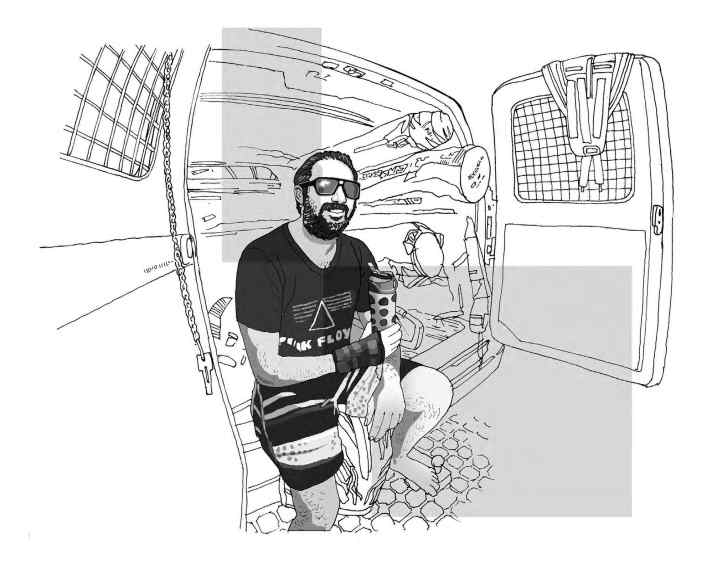
Alex, you grew up in Cuba before fleeing to the USA at the age of 21. What was life like in Cuba in the 1980s?
Cuba was bad for me! Communism is a terrible system. You had absolutely no opportunity to develop freely. No matter what you wanted to do, everything was limited to what the state allowed you to do - there were no dreams. In short, you had to be part of the system. If you had ideas or dreams, you were trapped in a cage. Only when you become part of the system do doors suddenly open - that's the case everywhere, in sport, in jobs and so on. If you don't have any ideas or visions, you can somehow accept it and live in the system. But not me! I started surfing at the age of 21 and came to America. The difference to the free world is enormous. Here, everything is possible without limits. Of course, it's not perfect here either, but it's up to you what you do with your life and not the system. That's why I'm here.
Anyone who had ideas or dreams was trapped in a cage. Only when you become part of the system do doors suddenly open. - Alex Morales
But you didn't learn to surf specifically to escape, did you? As far as I know, you were even on Cuba's Olympic windsurfing team back then.
Yes, exactly. You know, Cuba's economy is bad. There's actually no economy at all, so they market the country through sport. The country is starving, but they take care of sending athletes to the Olympics to gain prestige.
There were academies for many sports back then - including sailing. A friend of my family sent me to sailing school. Even before Cuba included windsurfing in the Olympic programme in 1982, I was a very good sailor.
But windsurfing was cooler! So colourful and exciting, sailing so dull and boring. I was hooked right from the start. Above all, the windsurfers on the beach got all the attention from the ladies. So I really wanted to do it too (laughs).
A friend of my family had equipment. We lived right on the water and I practised every day. I was on the water all day, always two days ahead of the others (smiles). 1987 was the year I was officially big enough to switch from Opti sailing to windsurfing. I quickly won the Junior Nationals and had already started building my own boards out of old polystyrene - booms made from mangroves tied together, base plates made from two nails, all sorts of things.
Did you ultimately qualify for the Olympic Games?
Yes, but I was too outspoken. You know, I've never been one to mince my words and sometimes had a pretty big mouth as a teenager. I just always did and said what I thought - or what I believed in. I've never held back. And yes, what can I say? I was qualified and ready, then you say one wrong word - and suddenly your passport isn't ready. And who has control over the passport? Exactly, the government! Then you can't go. It's sad, but true.
So you decide that it's time to leave the country on your own. What was the escape plan?
Originally, the plan was not to windsurf towards Florida, but to escape on a raft. It's simply more comfortable than windsurfing 200 to 300 kilometres in one go. We tried it twice by raft, but failed miserably. I was very lucky not to end up in prison or drown. If you get caught, you end up behind bars for a long time - if your raft breaks down far out or the engine fails, then ... well. Over 10,000 people died in the 1990s trying to escape.
What happened after the failed attempts?
After the engine let us down once, while we were still close to the coast, and the inflatable raft burst on the rocks another time when we were taking on water, I just thought: You know what, I think we need to surf over there (laughs). And that's what we did!
How intensive were the preparations?
Very intensive! We were extremely well prepared. We knew everything. Above all, we ultimately had an extra year to prepare - longer than originally thought. Because in the last week of April, the week of our planned escape, a late, unexpected cold front blew through, displacing the constant trade wind from the east, which basically takes you from the north coast of Cuba to Florida in a half-wind course, and bringing with it squalls with high waves. We couldn't set off. And in May it's already too late, the wind is getting weaker and weaker, summer is starting and the constant rain showers make the wind too unstable. So there is only a short period of time for a relatively safe getaway on the windsurfer as far as wind and weather conditions are concerned: Right between spring and summer. We had to wait a full year for the next chance.
One year later, at the end of April 1994: off we go again. This time the wind and weather played along. Go through the escape with us. What do you remember particularly well?
So, we were now a team of three. As well prepared as we could be. I had everything in duplicate: fins, base plates, ropes, plus a custom-made 7.5 mm sail with a robust aluminium mast instead of carbon. The only thing missing was a wetsuit, which I remember particularly well (laughs), because I got very cold at some point during the crossing.
We had been training for four to five hours a day for months to keep going over the long distance and went windsurfing at the same spot every day at ten o'clock in the morning to the minute - and not without reason: the coastguard comes back from the night shift at ten o'clock. Every day for two years, they saw us and just thought: Ah, the windsurfers are going out again for their daily training, everything is fine. But one day, on 27 April, we didn't just go to training. That day we didn't turn back and surfed further and further out, towards freedom, towards the USA. The next day we were in Key West - it was as simple as that.
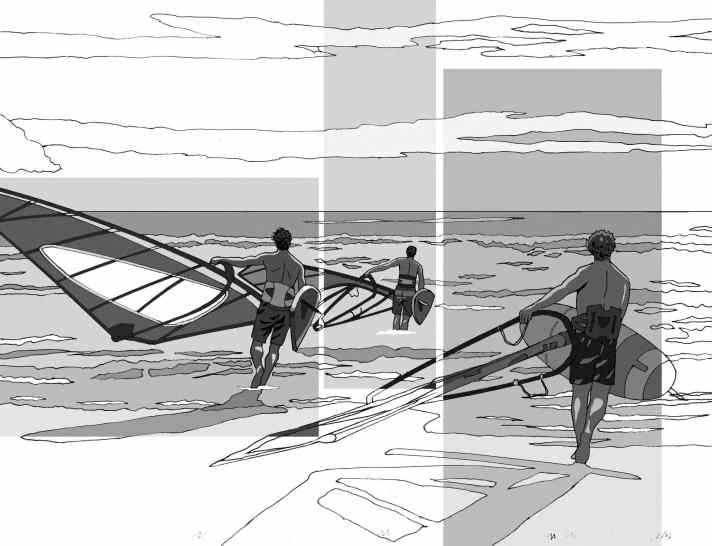
Wow! How long were you travelling for?
18 hours!
Were you so full of adrenalin that you didn't feel anything at all? Or how did you keep it up? I mean, after a few hours at a time on a windsurfing board, so far out on the open sea, there must come a point when you just can't take any more.
Sure, I was tired. I didn't eat for a long time. But at some point there's no turning back. And yes, you're also pretty excited - somehow you keep going.
In the middle of the night, around half past one, we decided to take a break. By then, we had already surfed a total of around 240 kilometres, including the tacking we had done. As the crow flies, it is actually "only" just over 200 kilometres from the north coast of Cuba to Key West. But you can't surf a straight line on a half-wind course. You should always try to start on a westerly course into the Gulf of Mexico. In principle, you should first aim for Texas in order to get out of sight of the Cuban coastguard off the north coast as quickly as possible. After about 30 kilometres to the northwest, you can tack for the first time - and then use the Gulf Stream to gain altitude.
We were on the road for 18 hours. We trained for this for two years. We couldn't have been better prepared.
Anyway, after 18 hours of surfing, we were lying there in the water on our tied-up boards, taking a break and drinking water. We were only about 30 kilometres from our destination when a large motorboat came hurtling towards us at full throttle. We thought the boat was going to run us over. As it was pitch black, we fired our only flare to be on the safe side - the boat slowed down and we cheered!
Who was on the boat? Did they pick you up and take you with them?
Yes! It was Captain Kevin. He picked us up and drove us to Key West. I just met him again a few weeks ago, 27 years later. It was so good to see him (grins).
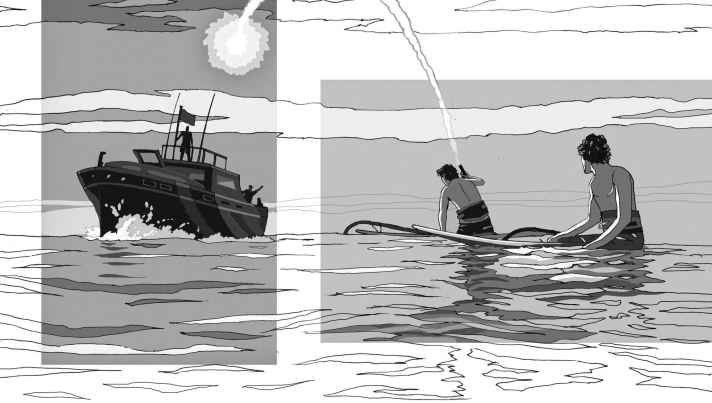
But did you already know that you were safe when the boat stopped?
Not really, but they were initially more afraid of us than we were of them, I think. They thought we might be pirates.
Windsurfing pirates!
You never know. They had their machine guns out and started asking questions. We couldn't speak English. My friend, who had learnt English at school for three years, was really lost for words at that moment. He simply didn't know anything else. Cuba, windsurfing! That was all we could say. Fortunately, Captain Kevin and his crew were very friendly. After they had searched us thoroughly, everything was very relaxed. It was an expensive, big boat - actually the Florida mayor's brother's boat. They had just returned from a baseball tournament in Mexico.
And how did the arrival in Florida go?
Quite simply! Captain Kevin had already informed the US Coast Guard. When we arrived, we had to undergo a few interviews. Relatives of mine who had been living in the USA for some time came to pick me up the next morning and took me to Miami. And that was it. All good - life is good.
Were there no hurdles for refugees travelling from Cuba back then?
It was relatively simple back then. Due to the Cuban Missile Crisis, there was clear, customised legislation. My case was clear.
You probably didn't give much thought beforehand to how you wanted to organise your new life in the USA. It was all about surviving and then being free, wasn't it?
Exactly, I had absolutely no plan. But you know what, I always knew which direction I wanted to go in. Because why am I here now, free, alive and suddenly have all the opportunities in the world? Thanks to windsurfing! So what am I doing with my life? Windsurfing!
Thanks to windsurfing, I am free, alive. I have all the possibilities. So what do I do with my life now? Right, windsurfing!
It's entirely up to me what I make of it - and that's the most important thing! Although I had my relatives on site at the time, I was basically on my own. I didn't want to be dependent on anyone. So unfortunately I never made it to Maui to become a professional windsurfer - that was the dream back then. But I had to make a living first - look for opportunities locally to survive. Looking back, I don't think it's a bad thing that the dream of Maui and becoming a professional windsurfer didn't materialise. It is what it is. I don't regret anything! What I'm doing now is at least as important to me. Windsurfing brought me here - and I now live from and still for windsurfing.
You now have your own board and sail brand and teach children in the Miami metropolitan area to windsurf. What was the state of windsurfing in the USA when you started to build your new life?
I arrived here shortly after windsurfing had boomed worldwide. I looked around and asked myself: Where is the party? Where are the rock stars? But the party was over, there was hardly anyone left. Most of the guests were already kitesurfing or had started stand-up paddling - now they were going wingfoiling.
And these are always the same people - namely the old windsurfers. No new people came along. It took me a lot of time and sweat to build something up. And all in all, it took a long time before I managed to introduce children to the sport. But I now see it as my task to rebuild the foundations of the pyramid from the ground up with young talent. We can't just sit around and talk about how things used to be. Then nothing will change. The people who made good money in the windsurfing industry back then are now retired on Maui and enjoying their lives. It's time for us to take matters into our own hands. Because the opportunities to make windsurfing great again are right in front of us. Nobody else is going to do it for us.
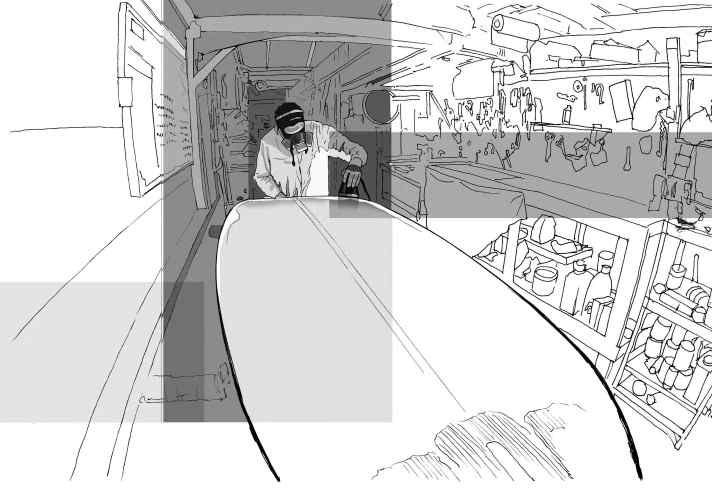
Tell us a bit about your work on site. Because you have your very own approach...
Yes, I cooperate with yacht clubs in Miami. With the help of their perfect infrastructure, we offer windsurfing development programmes for children and young people. But really the full programme! Lessons five days a week, three hours a day. Same time, every day. The programme is currently running in five large clubs in Miami, with 120 children enrolled in each. Parents drop their children off at the club after school as if they were going to football training. With my brand Tillo International, I develop special children's equipment for the clubs, among other things. I once counted the number of hours one of my boards was actually on the water: 12,000! In just under two years. I think I've laid the foundations for a kind of windsurfing factory for the next generation, which can be scaled up very far through the many yacht clubs in the USA.
I laid the foundations for a kind of windsurfing factory for the next generation in Florida.
My goal is to eventually have the programme running in hundreds of clubs and thus make windsurfing big again. If my escape has taught me anything, it's firstly that anything is possible - and secondly that effort pays off. I've never doubted anything since. All the little question marks in my head no longer exist. I was greatly rewarded for my efforts back then. And that's how it is everywhere in life. I just do it and know that it will be possible somehow.
The escape taught me a lot. I haven't doubted anything since then. All the little question marks in my head no longer exist. Everything is possible!
What's the best way to motivate children and young people?
Thanks to foiling! If you're bobbing across the water at twelve knots on the old Kona and a kiter jumps up next to you, then you've lost. You won't get the kids like that. But if you're suddenly the fastest and flying over the water, then it gets more interesting. Our watercraft is fast and cheap - compared to an Opti dinghy, for example. Hundreds of children are already on site at the clubs sailing Opti. Then they see a foiler flying past them and get a taste for it. They can then try out windsurfing directly in our programme.
Sounds great. But what about the lengthy process until the first sense of achievement? How long does it take from zero to the first foil flight?
Only about three months! I had a nine-year-old and a ten-year-old on the programme who learned to windsurf from scratch at the beginning of September: At the beginning of December, they were able to glide straight ahead on the foil. With my special, easy-to-ride foils with very short masts, they quickly get that first, addictive feeling of gliding or floating - without any great risk of accidents. Thanks to the short masts, the boards can't tip up and tip over so much during the first attempts at flying. It has to be said that the kids I've just told you about were on the water five days a week for three months - as is usual in our programme. Regardless of whether it was raining or the sun was shining, regardless of whether there were two or 20 knots of wind.
To round it off: Let's talk about your windsurfing brand Tillo International.
Oh, you know, I'm always very reserved when it comes to my brand. As you may have noticed, I'm much more enthusiastic about working with the kids in the yacht clubs.
I think I'm very good at dealing and communicating with people. Sometimes I have the feeling that I was the missing link in bringing windsurfing and the politically correct yacht clubs together - also on a human level. What I'm doing with my brand is just a materialistic realisation of the ideas I have in my head. I always want to improve something. And the brand was born out of necessity, because I was simply fed up with buying boards and always having problems with them. I've always done a bit of shaping - as I mentioned at the beginning, even back in my Cuba days. In 2010, things got more serious and I sold around 25 boards from my garage.
When two good friends of mine opened a surf shop two years ago, we got together and decided to go into production. Now it's getting more and more serious. At the beginning of the year we got Diony Guadagnino (former King of the Lake champion and renowned World Cup rider in several disciplines, editor's note) under contract. We had been talking for a long time, but in the end I told him: "Diony, I don't think we're ready for a team rider like you yet. But he said that we would manage - and he was right. We can do it! In hindsight, it was a great decision. He is the best thing that could have happened to the brand. You just can't doubt it. We can do it, nothing is impossible!
